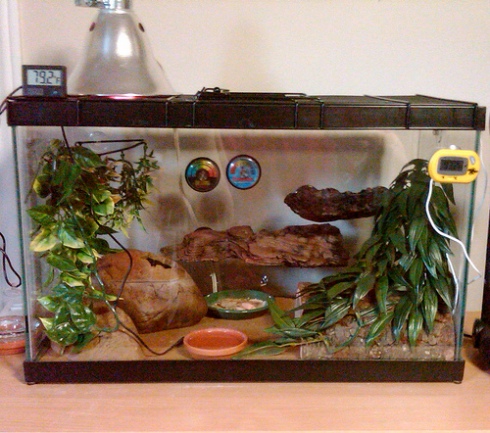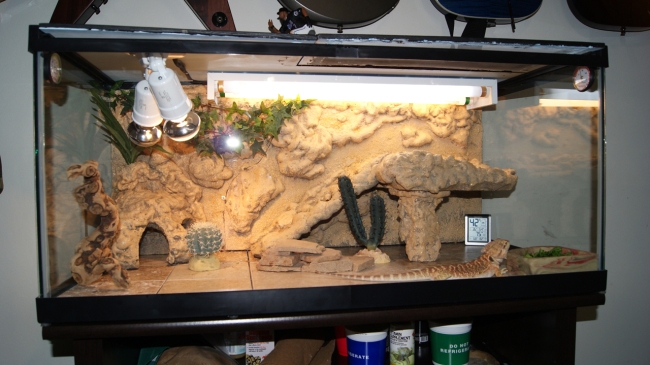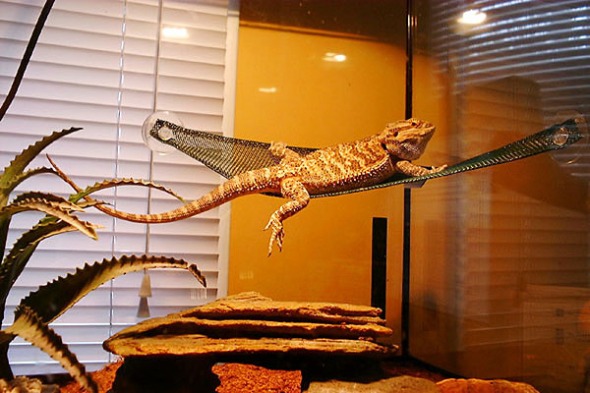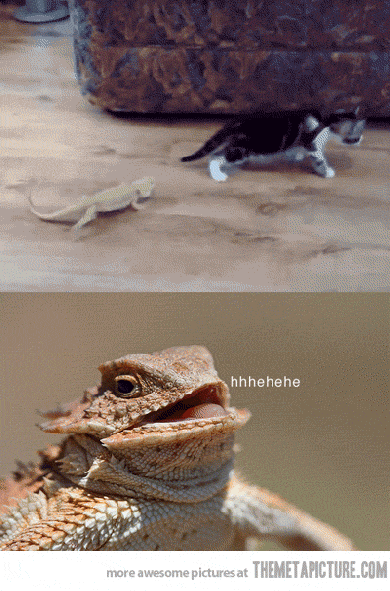Iguanas
-
They can get very large and are not limited in growth by the size of their cage. They can grow to be 6 feet in length.
-
You can start with your baby iguana in a 55 gallon fish tank but by the end of the year it will need a much larger enclosure that’s a minimum of 4 foot square and 6 feet tall. The taller the cage the better so that the iguana can climb up and down and choose which temperature he would like. Cages made with mostly wood or Plexiglas sides help hold in heat and humidity better than all mesh cages.
-
Substrate can be as simple as newspaper or more jungle-esque, like AstroTurf. Do not use wood shavings, corn cob bedding, sand, or crushed walnut shells. If ingested, these can cause an impaction.
-
Since Iguanas natural habitat is up in the jungle trees, it is essential to provide several branches that span the full height of the cage. The branches should be slightly larger than the circumference of the iguana.
-
They will need a basking spot that can maintain temps of 90-100F and the ambient air of the enclosure should hover around 80F. Heat lamps are fine as long as the iguana can’t touch it and burn itself.
-
They require a night day cycle to maintain circadian rhythms so a heating element that doesn’t emit light is essential.
-
Night time temps can dip to 70-75F so long as they have their basking spot in the morning
-
They require full spectrum light which includes UVA and UVB light. UVB light is essential so that the iguana can synthesize vitamin D3 which is used in the absorption of calcium. The basking branch should be no lower than 12 inches from the light as it is not as strong further away. Replace the bulbs every 6 months. Plant growth bulbs do not provide adequate UVB rays
-
Iguanas require a humid environment, much like their jungle environment, with 65-75% humidity. Easy ways to increase humidity include misting the cage and iguana a couple times a day or leaving large tubs of water in the cage. Extreme herp guys may invest in an ultrasonic fogger to maintain optimal humidity although there is a chance to over humidify the enclosure which can lead to illness
-
http://www.kingsnake.com/rockymountain/RMHPages/RMHgreen.htm
Leopard Geckos
-
A pair of adult leopard geckos can comfortably live in a 15 gallon fish tank with a secure mesh lid.
-
One end of the tank should be 86-88F and the other at 70-80F. Under tank heating pads are ideal because they will not burn the gecko or illuminate the tank at night like a heat lamp would. A good basking spot for a gecko would be a nice flat rock. Have the same number of basking areas as there are geckos in the tank.
-
Good substrates include newspaper and paper towels. Some people feel that sand is ok while others are concerned with the chance of ingestion.
-
Geckos are nocturnal creatures so no need to buy special full spectrum lights, but they do require a day night cycle.
-
Geckos require a lower humidity of 40%. Hidey holes with damp moss will provide areas of higher humidity that the gecko will seek out when it’s time to shed.
-
Water should be provided in a shallow dish.
Corn Snakes
-
Can live in a 15 gallon fish tank with a screen lid.
-
Good substrates include newspaper, paper towels, AstroTurf, and reptile bark. Stay away from wood shavings, sand, and corn cob bedding
-
Ambient tank temperature should be 70-80F with a basking area at 85F. Do not use hot rocks!
-
Luckily, corn snakes are happy with out additional humidity. 30% humidity or higher is adequate.
-
Corn snakes like to have several places to hide in
-
Water should be available in a shallow dish for drinking and bathing
-
http://www.kingsnake.com/rockymountain/RMHPages/RMHnewpage11.htm
Bearded Dragons
-
10-16” dragons will need a 40 gallon fish tank and 20”+ dragon will need a 75 gallon tank. Secure screen lids are essential.
-
Dragons require a lot of light since they are from the deserts of Australia. They will need a full spectrum bulb for UVA and UVB wavelengths and a heat bulb for basking temperatures.
-
The tank should have a hot side for basking at 95-100F and a cooler side at 85F. Temps can drop to 70-75F overnight. If the tank gets below 70F during the night an under the tank heat pad may be necessary.
-
Being a desert animal, dragons don’t need excessive humidity. As long as the enclosure has ventilation high humidity shouldn’t be an issue.
-
Good substrates include paper towels, newspaper, AstroTurf, or reptile carpet. Again…avoid wood shavings, sand, and corn cob bedding.
-
Branches for climbing and hidey holes are welcome and apparently beardies like hammocks too
-
Most of the dragon’s water requirement comes from its diet but daily misting and bathing can increase water consumption







Reblogged this on Exotic Animal Medicine for the Vet Tech.
Oh my god, that video is hilarious! Though cats can kill lizards, so of course, we must counsel owners against such things. Nice job with this post; it illustrates well the WIDE variety in husbandry across various types of herps. Some are pretty easy care, and others are very high maintenance!